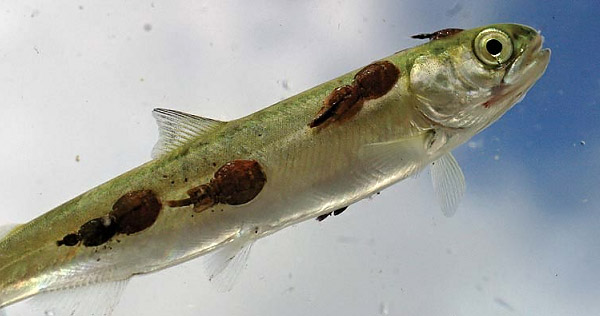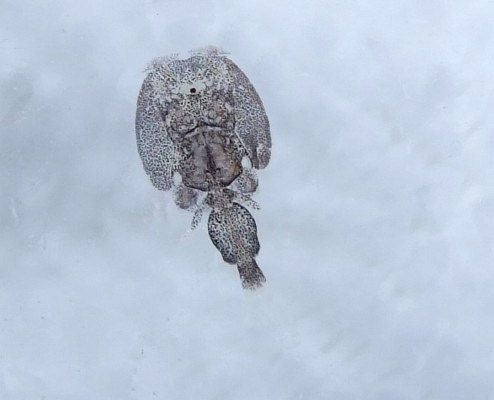|
| |
| 3. Dezember 2010 |
Zwei Studien zeigen, dass die von den Zuchtlachsfarmen
ausgehende Seelausverbreitung die Population der
Silberlachse im Broughton Archipelago gefährdet |
| |
| Im Oktober 2010 wurde von einer Gruppe von Wissenschaftlern eine Studie veröffentlicht, welche die Gefahren der Seelausverbreitung durch die Zuchtlachsfarmen auch zwischen den pazifischen Wildlachsarten nachweist. (Connors, B. M., Hargreaves, N. B., Jones, S. R. M. & Dill, L. M. (2010). Predation intensifies parasite exposure in the salmonid food chain. Journal of Applied Ecology, Vol. 47, 6, S. 1365 – 1371). Im Gebiet der Lachsfarmen im Broughton Archipelago sind die jungen Buckellachse (Pink salmon, Oncorhynchus gorbuscha) stark von Seeläusen befallen. Werden sie von ihren Jägern, den erwachsenen Silberlachsen (Coho salmon, O. kisutch) gefressen, so erhöht sich auch der Seelausbefall der Silberlachse um das zwei- bis dreifache. Die Forscher kommen zu folgendem Schluss: „These results suggest that, by evading predation, salmon lice can accumulate up juvenile salmon food webs. Predators, such as coho, can experience a two- to threefold increase in parasite exposure through predation on infected prey that would otherwise occur through passive exposure to infective larvae. … For larger predatory wild juvenile salmon, the risk of louse transmission from farmed salmon may therefore be greater than previously appreciated. These findings argue for an ecosystem perspective in monitoring and managing the marine environment in areas of intensive salmon aquaculture that includes the productivity and ecological interactions of all salmonid species.“ |
| |
 |
mit Seeläusen (Lepeophtheirus salmonis) befallener Junglachs
© Living Oceans Society, Rising Tide, Fall 2010, www.livingoceans.org |
| |
| Die zweite Forschungsarbeit untersucht die Laichrate der Silberlachse in Abhängigkeit vom Seelausbefall und der Anwesenheit von Zuchtlachsfarmen (Connors, B. M., Krkošek, M., Ford, J. & Dill, L. M. (2010). Coho salmon productivity in relation to salmon lice from infected prey and salmon farms. Journal of Applied Ecology, Vol. 47, 6, S. 1372 – 1377). Die Ergebnisse zeigen, dass die Laichrate der zurückkehrenden Silberlachse im Broughton Archipelago in den Jahren zwischen 1975 und 2007 während einer Phase wiederholter Seelausepidemien in den Zuchtlachsfarmen sieben Mal geringer war als in anderen Silberlachspopulationen, die dieser Parasitendusche aus den Lachsfarmen nicht ausgesetzt waren: „During a period of recurrent salmon louse infestations in a region of open-pen salmon farms, coho salmon productivity (recruits per spawner at low spawner abundance) was depressed approximately seven-fold relative to unexposed populations. Alternate hypotheses fort he observed differences in productivity – such as declines in coho prey, perturbations to fresh water habitat or stochasticity [Wahrscheinlichkeitsberechnungen], are unlikely to explain this pattern. Lice parasitizing juvenile coho salmon were likely to be trophically transmitted during predation on parasitized juvenile pink salmon as well as directly transmitted from salmon farms.“ |
| Die Forscher ziehen folgende Schlussfolgerungen: „The finding that species interactions may cause effects of pathogen transmissions from farmed to wild fish to propagate up a marine food web has important conservation implications: 1) the management of salmon aquaculture should consider and account for species interactions and the potential for these interactions to intensify pathogen transmissions from farmed to wild fish, 2) the ecosystem impact of louse transmission from farmed to wild salmon has likely to have been previously underestimated and 3) comprehensive monitoring of wild salmon and their population dynamics in areas of intense salmon aquaculture should be a priority to determine if open-pen salmon aquaculture is ecologically sustainable.“ |
| Diese inzwischen erdrückenden Forschungsergebnisse zu den Seelausgefahren aus den Zuchtlachsfarmen für die pazifischen Wildlachse sollten das kanadische Fischereiministerium wie auch die Fischfangkonzerne wachrütteln. Doch anstatt zu handeln werden die notwendigen Investitionen in geschlossene Systeme weiter hinausgeschoben. Es ist immer noch billiger in bewährter Manier alle Forschungsergebnisse zu leugnen und die beteiligten Forscher systematisch zu diskreditieren. Federführend hierbei ist der Lobbyverband der Fischfarmkonzerne in BC, die BC Salmon Farmers Association. Die Lobbyarbeit dieses Verbandes reicht so weit in kanadische Fischereiministerium hinein, dass dieses auf seiner offiziellen Website (www.dfo-mpo.gc.ca) Artikel platziert, die die neuen Forschungsergebnisse anzweifeln und in den Schmutz ziehen („This Science is Fishy“). Gleichzeitig werden Forschungsstudien, an denen sogar Fischereibiologen des Ministeriums beteiligt waren und die unliebsame Ergebnisse über die von den Fischfarmen ausgehenden Seelausgefahren dokumentieren, systematisch unterschlagen. |
| In seinem Artikel „Alexandra’s Epiphany“ (gemeint ist die Biologin und Fischfarm-Kritikerin Alexandra Morton) schrieb Roy Grigg im Courier-Islander vom 03.12.2010: „ It is not really here to provide seafood to affluent consumers, to create employment in coastal communities suffering from an ailing wild fishery, to nourish supportive businesses, or to willingly pay taxes. These are merely inadvertent effects, the collateral benefits of keeping stock value high and returning generous dividends to investors. Its objective is continual profit and perpetual growth. Everything it does is a means to this primary objective.“ Anstatt den eigenen gewichtigen Beitrag zum Niedergang der Wildlachsbestände einzugestehen und aus den Fehlern zu lernen, wird lieber auf in absehbaren Zeiträumen kaum zu beeinflussende komplexe Faktoren verwiesen: „Klimawandel“ oder allgemein „Urbanisierung“. Grigg schreibt: „Surely the innumerable scientific studies implicating open net-pen salmon farming in damage to wild salmon populations is a significant enough factor to mention. But this would imply culpability. And culpability would have a negative affect on stock prices. So the industry assumes a strategy of wholesale denial. Deny responsibility to the edge of absurdity. Evade, deflect, divert, obscure and delay is its response to solid, peer-reviewed science. Anything to keep its stock prices high.“ Für Grigg war es nicht überraschend, dass die Lachsfarmindustrie die neuen Forschungsergebnisse in Grund und Boden verdammt. Die Ergebnisse seien „bad news for stock prices“. „So the industry’s response to the latest peer-reviewed scientific study will be predictable. Dr. John Reynolds of Simon Fraser University led a team of researchers studying the relationship between salmon farms, sea lice and wild fish. The findings once again confirmed earlier studies: first, where open net-pen fish farms do not exist, the level of lice infection in wild salmon is about 5 %; second, after migrating fish pass salmon farms, their level of infection is seven to 30 times higher; and three, of the two species of lice that live in these West Coast waters, the ones infecting these migrating fish are so-called "salmon specialists". But this is bad news for stock prices. So it will be denied with the same obscure rationalizations applied to the mounting barrage of other damning scientific studies.“ |
| |
 |
Seelaus (Lepeophtheirus salmonis)
© Stan Proboszcz, Watershed Watch |
| |
 zurück zurück |
|
|


